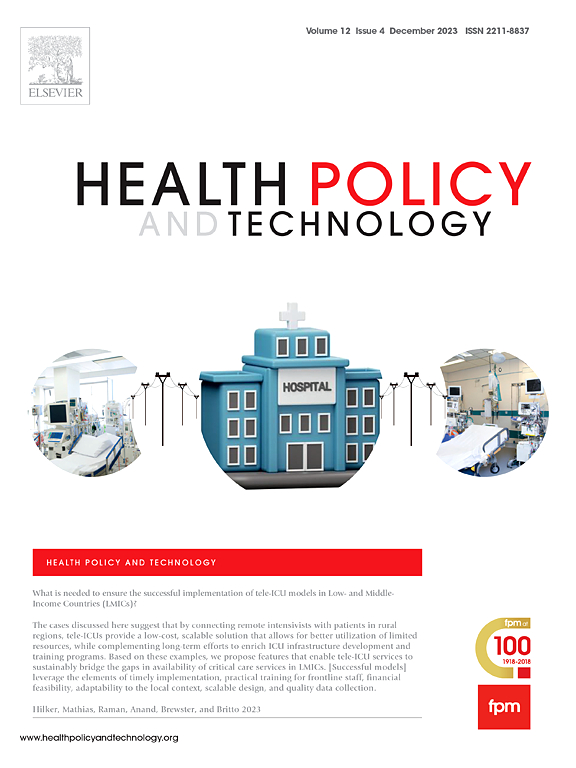Developing economic evaluation guidelines for the Kingdom of Saudi Arabia: Engagement of local experts
IF 3.7
3区 医学
Q1 HEALTH POLICY & SERVICES
引用次数: 0
Abstract
Objectives
Economic evaluation has increased due to the emergence of national health technology assessment (HTA) agencies. This study aims to develop a country-specific guideline for conducting economic evaluation in the Kingdom of Saudi Arabia (KSA) as an HTA component to determine the value for money of new health interventions.
Methods
The study conducted a real-time Delphi survey using 17 items from the method component of the Consolidated Health Economic Evaluation Reporting Standards checklist as foundation for guidelines. Consensus was reached for the relevance of guideline recommendations for the KSA healthcare system. We set a threshold of 80 % for agreement and an interquartile range less than three on a nine-point Likert scale. Interim analysis provided feedback for recommendations of items if no consensus exists. A natural language processing (NLP) approach was employed to examine the relationship between experts’ comments and consensus decisions.
Results
The study recruited 78 % experts with an average response progress rate of 97.2 %. Interim analysis provided a 63 % adjustment rate for recommendations with the majority requiring further clarification (65 %). The guidelines concluded with a consensus on 76 % of recommendations, while four remained undetermined, namely, choice of discount rate, use of same rates for health benefits and costs, outcome selection, and gross costing. The NLP results supported the consensus decision.
Conclusions
Expert consensus contributed to the development of informative guidelines relevant to KSA. The guidelines serve as a reference case, thus providing a foundation for HTA practices, reimbursement decisions, and future research for the KSA and its neighboring countries.
为沙特阿拉伯王国制定经济评价准则:当地专家的参与
目的随着国家卫生技术评价机构的出现,经济评价有所增加。本研究旨在制定一项针对具体国家的指导方针,以便在沙特阿拉伯王国(KSA)开展经济评估,作为卫生评估的一个组成部分,以确定新的卫生干预措施的物有所值。方法采用《综合卫生经济评价报告标准》方法部分的17个项目进行实时德尔菲调查,作为指导方针的基础。达成共识的相关性指南建议的KSA医疗保健系统。我们设定了80%的一致性阈值,在9分李克特量表上,四分位数范围小于3。如果没有协商一致意见,临时分析提供了对项目建议的反馈。采用自然语言处理(NLP)方法来检验专家意见与共识决策之间的关系。结果共招募专家78%,平均应答率97.2%。中期分析显示,建议的调整率为63%,大多数建议需要进一步澄清(65%)。最后,指南对76%的建议达成了共识,而四项建议仍未确定,即选择贴现率、使用相同的健康福利和成本率、结果选择和总成本计算。NLP结果支持共识决定。结论专家共识有助于制定与KSA相关的信息指南。该指南可作为参考案例,从而为卫生保健协会的实践、报销决策和沙特阿拉伯及其邻国的未来研究提供基础。
本文章由计算机程序翻译,如有差异,请以英文原文为准。
求助全文
约1分钟内获得全文
求助全文
来源期刊

Health Policy and Technology
Medicine-Health Policy
CiteScore
9.20
自引率
3.30%
发文量
78
审稿时长
88 days
期刊介绍:
Health Policy and Technology (HPT), is the official journal of the Fellowship of Postgraduate Medicine (FPM), a cross-disciplinary journal, which focuses on past, present and future health policy and the role of technology in clinical and non-clinical national and international health environments.
HPT provides a further excellent way for the FPM to continue to make important national and international contributions to development of policy and practice within medicine and related disciplines. The aim of HPT is to publish relevant, timely and accessible articles and commentaries to support policy-makers, health professionals, health technology providers, patient groups and academia interested in health policy and technology.
Topics covered by HPT will include:
- Health technology, including drug discovery, diagnostics, medicines, devices, therapeutic delivery and eHealth systems
- Cross-national comparisons on health policy using evidence-based approaches
- National studies on health policy to determine the outcomes of technology-driven initiatives
- Cross-border eHealth including health tourism
- The digital divide in mobility, access and affordability of healthcare
- Health technology assessment (HTA) methods and tools for evaluating the effectiveness of clinical and non-clinical health technologies
- Health and eHealth indicators and benchmarks (measure/metrics) for understanding the adoption and diffusion of health technologies
- Health and eHealth models and frameworks to support policy-makers and other stakeholders in decision-making
- Stakeholder engagement with health technologies (clinical and patient/citizen buy-in)
- Regulation and health economics
 求助内容:
求助内容: 应助结果提醒方式:
应助结果提醒方式:


